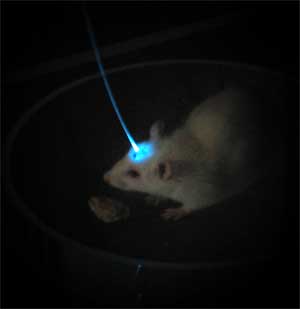Science Fiction
Dictionary
A B C D E F G H I J K L M N O P Q R S T U V W X Y Z
Optogenetics - Fiber Optic Brain Control

Optogenetics is a technique for controlling the behavior of specific groups of nerve cells in the brain. Genetically engineered viruses carry light-triggered proteins into the brain of the animal; the viruses can be tailored to attach themselves to specific groups of cells.
The brain cells can then be activated by focused light; only those cells that are infected will respond to the light delivered into the brain by fiber optic strand.

(Optogenetically controlled mouse)
The mouse pictured above has a fiber optic strand implanted in the top of its skull; when the light is turned on, the mouse is compelled to run in circles. This video shows what happens when this optogenetically-controlled animal is "switched on":
(Optogenetically controlled mouse video)
Other mice have been trained to prefer certain rooms within a maze by activating parts of the brain that suggest that a reward has been provided (like food) whenever they are in that room.
The intent of this research is to eventually find effective treatments for brain diseases like Alzheimer's, Parkinson's and epilepsy. Tailored optogenetic viruses could specifically work on the appropriate cells, rather than using chemicals that flood the entire brain.
This scenario should look familiar to science fiction fans as well. In a way, this is similar to the process by which a person is assimilated into the Borg in the ST:TNG series. The Borg start by injecting nanoprobes into the bloodstream which latch onto specific cells.
The idea that you could shine a light onto a person's brain and make them feel "rewarded" probably reminds Niven fans of the tasp from his 1970 novel Ringworld. This device is able to stimulate the pleasure centers in the brain remotely, without any sort of special surgical implant.
I'm also remembering sf stories in which remarkable inventions are created by "forcing" their genius creators to greater and greater focus and concentration. If I remember correctly, that method is used by the Mule in Asimov's Foundation series from the 1950's.
Update: Thanks to AJ for reminding me about the mindrot microbe from Vernor Vinge's 1999 novel A Deepness in the Sky.
"Focusing ennobles. It is the key to Emergent success, and a much more subtle thing than you can imagine. It's not just that we've created a psychoactive microbe. This is one whose growth within the brain can be controlled with millimeter precision - and once in place, the ensemble can be guided in its actions with the same precision.""Don't you see? We can improve the attention-focusing aspects of consciousness: we can take humans and turn them into analytical engines."
(Read more about Vinge's focusing)
End update.
From WSJ Training a Light on Brain Disease via Medgadget.
Scroll down for more stories in the same category. (Story submitted 6/24/2009)
Follow this kind of news @Technovelgy.| Email | RSS | Blog It | Stumble | del.icio.us | Digg | Reddit |
Would
you like to contribute a story tip?
It's easy:
Get the URL of the story, and the related sf author, and add
it here.
Comment/Join discussion ( 3 )
Related News Stories - (" Medical ")
Bone-Building Drug Evenity Approved
'Compounds devised by the biochemists for the rapid building of bone...' - Edmond Hamilton, 1932.
BrainBridge Concept Transplant Of Human Head Proposed
'Briquet’s head seemed to think that to find and attach a new body to her head was as easy as to fit and sew a new dress.' - Alexander Belaev (1925)
Natural Gait With Prosthetic Connected To Nervous System
'The leg was to function, in a way, as a servo-mechanism operated by Larry’s brain...' - Charles Recour, 1949.
Brain Implant Is Able To Capture Your Inner Dialogue
'So you see, you can hide nothing from me.'
Technovelgy (that's tech-novel-gee!) is devoted to the creative science inventions and ideas of sf authors. Look for the Invention Category that interests you, the Glossary, the Invention Timeline, or see what's New.
Science Fiction
Timeline
1600-1899
1900-1939
1940's 1950's
1960's 1970's
1980's 1990's
2000's 2010's
Current News
Bone-Building Drug Evenity Approved
'Compounds devised by the biochemists for the rapid building of bone...'
Secret Kill Switch Found In Yutong Buses
'The car faltered as the external command came to brake...'
Inmotion Electric Unicycle In Combat
'It is about the size and shape of a kitchen stool, gyro-stabilized...'
Grok Scores Best In Psychological Tests
'Try to find out how he ticks...'
PaXini Supersensitive Robot Fingers
'My fingers are not that sensitive...'
Congress Considers Automatic Emergency Braking, One Hundred Years Too Late
'The greatest problem of all was the elimination of the human element of braking together with its inevitable time lag.'
The Desert Ship Sailed In Imagination
'Across the ancient sea floor a dozen tall, blue-sailed Martian sand ships floated, like blue smoke.'
The Zapata Air Scooter Would Be Great In A Science Fiction Story
'Betty's slapdash style.'
Thermostabilized Wet Meat Product (NASA Prototype)
There are no orbiting Michelin stars. Yet.
Could Crystal Batteries Generate Power For Centuries?
'Power could be compressed thus into an inch-square cube of what looked like blue-white ice'
India Ponders Always-On Smartphone Location Tracking
'It is necessary... for your own protection.'
Amazon Will Send You Heinlein's Knockdown Cabin
'It's so light that you can set it up in five minutes by yourself...'
Is It Time To Forbid Human Driving?
'Heavy penalties... were to be applied to any one found driving manually-controlled machines.'
Replace The Smartphone With A Connected Edge Node For AI Inference
'Buy a Little Dingbat... electropen, wrist watch, pocketphone, pocket radio, billfold ... all in one.'
Artificial Skin For Robots Is Coming Right Along
'... an elastic, tinted material that had all the feel and appearance of human flesh and epidermis.'
Robot Guard Dog On Duty
I might also be thinking of K-9 from Doctor Who.
